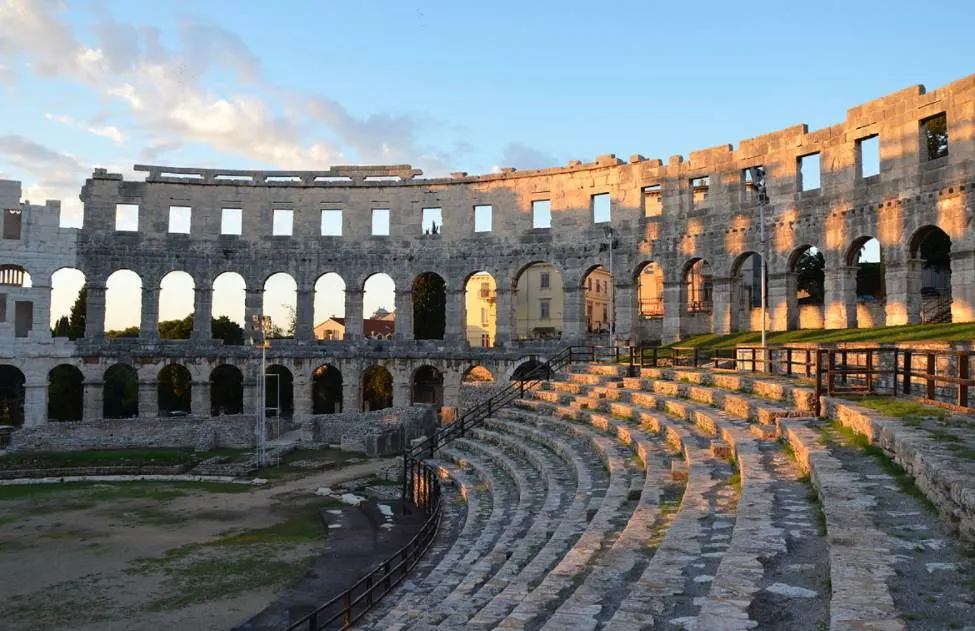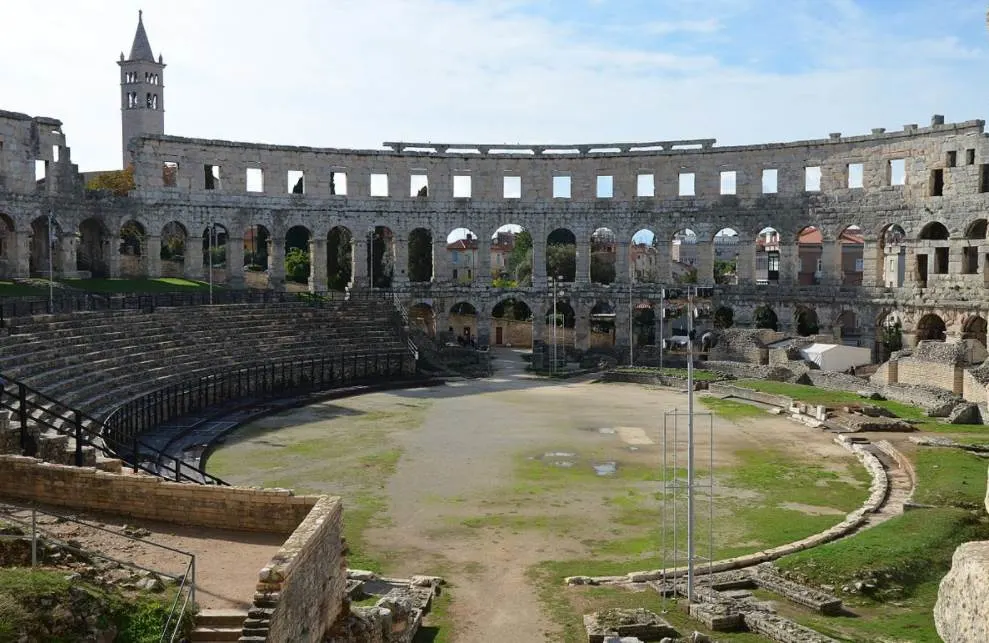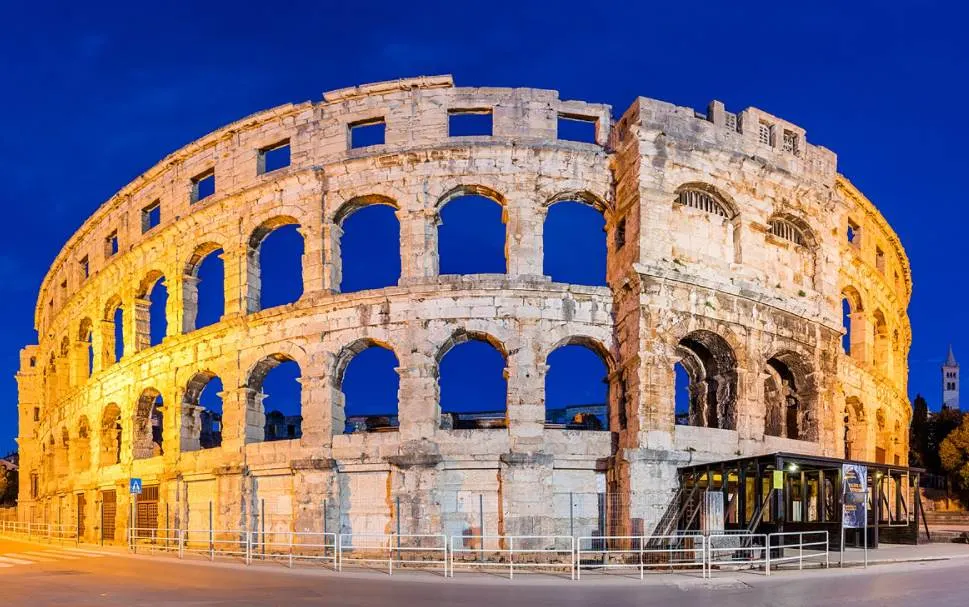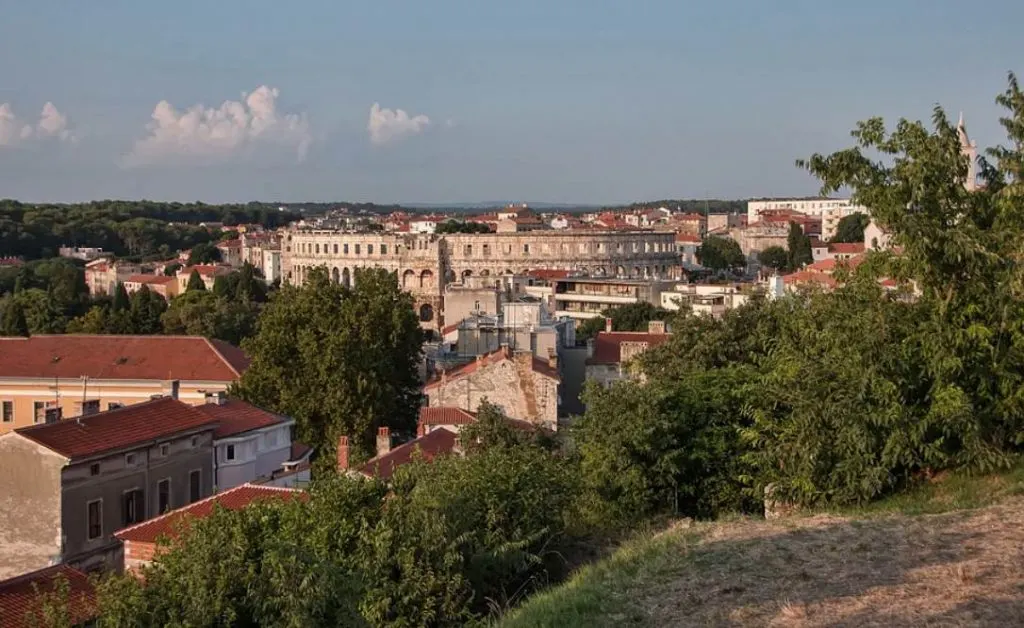The equivalent of modern-day stadiums in ancient Rome were massive Roman Amphitheaters. Although the things that happened there are unspeakable, some of these incredible structures still stand today.
Let’s take a closer look at some of the most interesting facts about the Pula Arena, one of the largest and best-preserved ancient Roman entertainment venues outside of Italy.
1. The arena is located in a city with the same name in Croatia
The Pula Arena is an ancient Roman amphitheater located in the city of Pula in Croatia. This is the 8th-largest city in the country and the largest city in Istria County in the utmost northwestern part of Croatia.
What’s remarkable is that this part of Croatia is located just near the border of Italy (although part of Slovenia lies in between) and it’s an Italian-speaking region. It has been an important trading and administrative center since Roman times.
Although the city is relatively small with less than 60,000 inhabitants, it features multiple ancient monuments. Apart from the amphitheater, there’s also a well-preserved Temple of Augustus and a famous arch called the Triumphal Arch of the Sergii.

2. The original structure was built during the reign of Augustus
When gladiators emerged remains unknown as historical records either place their origin with Etruscans or in the 4th century B.C., but what we do know is that they were the heroes of their time.
Gladiatorial fights inside massive arenas were one of the most popular forms of entertainment in ancient Rome, apart from perhaps taking a bath in one of the gigantic Roman Bathhouses that could be found all across the Roman Empire.
The peak of the gladiator’s fame happened between the 1st century B.C. and the 2nd century A.D., and most of the amphitheaters date back from this period. Because Pula, known in ancient times as Pietas Julia, an amphitheater was already built during the reign of Augustus, the first Roman Emperor.
This timber structure was completed between 2 and 14 A.D. and was replaced by a stone during the reign of Emperor Claudius between 41 and 54 A.D.

3. The current arena was completed at the same time as the Colosseum

We all know the biggest and most famous Roman Amphitheater ever constructed, the Colosseum in Rome. This incredible structure was completed between 70 and 80 A.D. with the help of the spoils of the First Jewish-Roman War and the subsequent sack of Jerusalem.
This was part of a major propaganda campaign launched by newly appointed Roman Emperor Vespasian, a man with a humble background who was the unlikely successor of Emperor Nero.
His propaganda campaign was launched all across the empire and included the construction of the Pula Arena. After all, Pietas Julia was expanded quickly and the original stone amphitheater didn’t suffice anymore to hold large spectacles which included gladiator fights and beast hunts.
The project was commissioned by Vespasian in 79 A.D. and completed during the brief reign of his son Titus in 81 A.D. This transformed the arena into the massive structure that still stands today, almost 2,000 years later.

4. How big is the Pula Arena and how many people could be seated?
So how many people could enjoy gladiators fighting to the death of animals being slaughtered during beast hunts at the Pula Arena?
Here are the dimensions of this ancient arena:
- Length: 132.45 meters (434.5 feet)
- Width: 105.1 meters (344.8 feet)
- Arena size: 67.95 x 41.65 meters (222.9 x 136.6 feet)
- Height: 32.45 meters (106.5 feet)
- Capacity: 23,000 spectators
Although the seating capacity of the arena is less than half of that of the Colosseum, it’s still one of the largest extant Roman Amphitheaters and one of the largest ever built in the Roman Empire.

5. The arena is still used as a popular concert venue today
Frank Sinatra once held a concert in the early 1990s at the Pompeii Amphitheater, but this was an exclusive event. One of the most remarkable facts about the Pula Arena in Croatia is that it’s still extensively used as a concert venue today.
Some of the artists that have performed here over the years are the Foo Fighters, Luciano Pavarotti, and Grace Jones, to name just a few. Other uses of the amphitheater include operas, ballets, sports competitions, and the Pula film festival.
During concerts, the arena is completely transformed and about 5,000 seats are placed so people can enjoy the performance in a location that was once used for blood battles of gladiators, quite amazing!

More interesting facts about the Pula Arena
6. One of the main reasons why the ancient city of Pietas Julia became such an important city was because it was located along the Via Flavia. This ancient Roman road allowed travelers to go from Pula to Aquileia and Rome.
Julius Caesar was the man who elevated the status of the city and it quickly grew to a population of over 30,000 inhabitants in the 1st century B.C. It features a sewer system and had running water to accommodate the population, people who wanted to be entertained as well.
7. The arena features a total of 15 gates through which spectators could access the stands. It also featured underground passageways so gladiators and animals could be hoisted onto the arena floor during games.
The Pula Arean is the only extant ancient Roman amphitheater of which the 4 exterior side towers still stand. These towers featured cisterns that could provide the spectators with drinking water.

8. Although the arena doesn’t feature a roof today, this wasn’t the case in ancient times. A special construction allowed a sail, or “velaria,” to cover the spectators who would otherwise have been baking in the sun.
9. The most prominent feature of the architectural design of the arena is the 72 arches that make up the first two floors of the arena. This makes it appear very similar to the Colosseum in Rome as it features the same design.
The main building material of the arena was limestone and only the side facing the sea features 3 levels as all other sides only feature 2 levels. The top level of the arena doesn’t feature arches, a feature used to carry the weight of the structure, but 64 rectangular openings.

10. Fights to the death and executions were not banned inside this particular arena until the year 681. Until the late 7th century, prisoners who were sentenced to death were forced to fight each other or were devoured by wild animals.
11. Just like many other structures built during the Roman Empire, the stones used to build this immense structure were being used to construct other buildings. This happened until the year 1789 when stones were taken from the arena to build the foundation of the belfry of Pula Cathedral.
12. The Pula Arena is not just a symbol of the city of Pula but all of Croatia. This is emphasized by the fact that this incredible landmark was added to the 10 kuna banknote, the Croatian currency issued by the Croatian National Bank.

